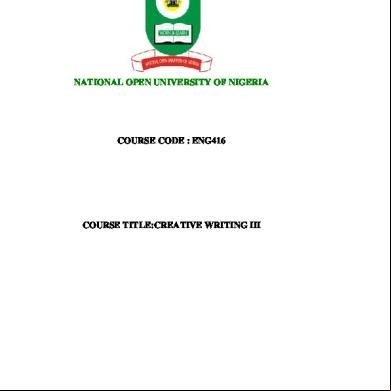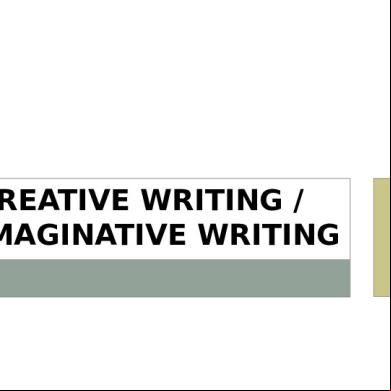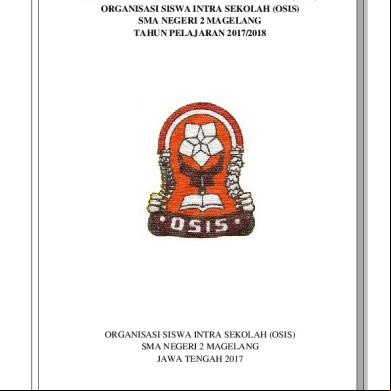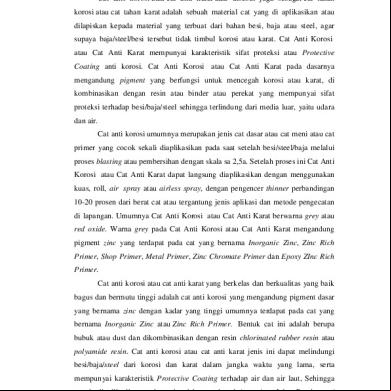Tips For Creative Academic Writing (1) 2kd57
This document was ed by and they confirmed that they have the permission to share it. If you are author or own the copyright of this book, please report to us by using this report form. Report 445h4w
Overview 1s532p
& View Tips For Creative Academic Writing (1) as PDF for free.
More details 6h715l
- Words: 1,074
- Pages: 4
So how do I produce Creative Academic writing? Golden Rule Always the ultimate purpose of academic writing: to convey, inform, or persuade your readers of your thesis of an academic topic. You can’t and shouldn’t combine academic writing and creative writing to become one new genre. Rather, you should recognize that select opportunities exist to include creative touches in your academic writing.
Tips for Producing Creative Academic Writing: 1- that creative academic writing is still academic writing. So, take Farah Quinn’s and how she says to use salt: “secukupnya” when cooking. Apply this same idea with creativity in academic writing. Creative touches in academic writing are like salt: a little bit adds a lot of flavor, but too much and it ruins the dish. So: “just enough” or “secukupnya.” Consider: that: “A little bit goes a long way” (Barrata, Alex).
1-how, 2-when, 3-how much
2-Figurative Language which may include: metaphors, analogies, or similes.
Simile: A comparison of two things using the words “like” or “as.” Example: “Losing your best friend feels like your heart is waves crashing against rocks.” The simile here illustrates the pain of losing your friend. The illustrative language makes it interesting and may serve as an appropriate first line of a paper to draw the readers into the paper.
Metaphor: A comparison that does NOT use the words “like” or “as.” Example: “Offering a ‘taste’ of college life will entice prospective high school seniors.” The metaphor here illustrates the high school senior’s college experience by using the word “taste,” which makes the reader think about a sampling of food.
3-Abstract or Figurative Language: Sometimes in the appropriate context, using abstract language can create a creative touch to academic writing. What happens to a dream deferred? Langston Hughes Does it dry up Like a raisin in the sun? Or fester like a sore-And then run? Does it stink like rotten meat? Or crust and sugar over-like a syrupy sweet? Maybe it just sags like a heavy load. Or does it explode Look at how this poem uses descriptive language and imagery to convey its point about a dream deferred. While you can’t always use descriptive language and you can’t use it continuously, a little bit in an academic paper adds color to the writing and livens it up. Example of descriptive language used in an academic paper: “Teachers and lecturers often face the heavy load of grading. The massive amounts of papers can make a teacher’s head feel about ready to explode. However, if the teachers allow their students to write about topics that interest them, then they may find that the papers are more interesting because the students, as the writers, are more engaged in their topic, which thereby makes it a more lively paper to read.”
5-Don’t add creativity for creativity’s sake. the purpose of your academic writing. This means don’t just add creative touches because you are trying to make the paper more creative. that the point of an academic paper is still to convey a point & to your thesis, so make sure that you don’t lose sight of your goal while trying to make your academic writing more interesting. Important Tip
And if the creative writing touches do not work to further the thesis than DO NOT USE THEM!
6-Use italics or bold for emphasis. Example: “Unlike their Caucasian counterparts, Mexican-American usually are poor.” In the above example, the writer specifically used italics on the word “are” to give it emphasis.
7-Break grammatical rules sparingly, but when necessary to prove a point.
Example A: “ 9-11. Terror. Death. Destruction.”
compare with
Example B: “9-11 brought terror, death, and destruction.”
Example B, though grammatically incorrect, gives a more creative touch to the point. The author may have chosen to do this because most American readers know the effects of 9-11. The author probably chose to write this at the beginning of the paper, in the introduction to dramatize the point and draw the readers or “hook” their interest into the paper.
8-Use rhetorical questions. A Rhetorical question is a kind of question that is not intended to be answered by someone. Example: “Why do you think God put men and women together?” The rhetorical question appeal to the reader and draws them into the essay, because the use of a question implies that there is a reason to ask the question and that there is someone reading or listening who can answer the question. The rhetorical question can also influence the reader to consider the implication of the question and in that way, rhetorical questions can also lead the reader to agree with the writer. (This is especially useful if the paper is an argumentative or a persuasive writer, trying to convince the writer of something.) 9-Use personal stories or anecdotes to illustrate a point (or to hook the readers in the introduction and/or the conclusion). Example: Starting a persuasive paper (about the dangers and drinking and driving) by telling a story about a boy who was paralyzed after a car accident when a drunk driver hit him while he was riding on his bicycle.
10-Use an illustrative phrase or expression of imagery to add creativity. Example: “The true story behind the film, “Mississippi Burning” is soul-crushing, and remains a stain on American history.” In the above example, the information is conveyed: the point is about film “Mississippi Burning”, but the illustrative language portray the negativity of this true story and the effect it had on American history in a very creative way.
11: Title: that your title is the first opportunity you have to grab your readers’ attention and to make the paper interesting for them. Take advantage of this chance to add creative touches to the title and to intrigue your readers/appeal to them to keep reading your piece of writing.
Examples of Real Titles that exist in Ebsco journal articles: “Harry Potter and the Terrors of the Toilet” “Twilight is Not Good for Maidens: Gender, Sexuality, and the Family in Stephenie Mayer’s ‘Twilight’ Series,
12-Conclusions: Similar to Introductions, conclusions are also a chance for you, as writers, to add an extra touch of creativity to your writing. Example: While many may not consider zombies an obviously educational subject, analyzing them and their habits in this film demonstrates a connection between the twenty-first century living habits of many Americans.
Notes:
Works Cited Baratta, Alex. “Creative Academic Writing.” http://www.e-space.mmu.ac.uk/espace/bitstream/2173/30596/2/CREATIVE%20ACADEMIC%20WRITING.pdf
Tips for Producing Creative Academic Writing: 1- that creative academic writing is still academic writing. So, take Farah Quinn’s and how she says to use salt: “secukupnya” when cooking. Apply this same idea with creativity in academic writing. Creative touches in academic writing are like salt: a little bit adds a lot of flavor, but too much and it ruins the dish. So: “just enough” or “secukupnya.” Consider: that: “A little bit goes a long way” (Barrata, Alex).
1-how, 2-when, 3-how much
2-Figurative Language which may include: metaphors, analogies, or similes.
Simile: A comparison of two things using the words “like” or “as.” Example: “Losing your best friend feels like your heart is waves crashing against rocks.” The simile here illustrates the pain of losing your friend. The illustrative language makes it interesting and may serve as an appropriate first line of a paper to draw the readers into the paper.
Metaphor: A comparison that does NOT use the words “like” or “as.” Example: “Offering a ‘taste’ of college life will entice prospective high school seniors.” The metaphor here illustrates the high school senior’s college experience by using the word “taste,” which makes the reader think about a sampling of food.
3-Abstract or Figurative Language: Sometimes in the appropriate context, using abstract language can create a creative touch to academic writing. What happens to a dream deferred? Langston Hughes Does it dry up Like a raisin in the sun? Or fester like a sore-And then run? Does it stink like rotten meat? Or crust and sugar over-like a syrupy sweet? Maybe it just sags like a heavy load. Or does it explode Look at how this poem uses descriptive language and imagery to convey its point about a dream deferred. While you can’t always use descriptive language and you can’t use it continuously, a little bit in an academic paper adds color to the writing and livens it up. Example of descriptive language used in an academic paper: “Teachers and lecturers often face the heavy load of grading. The massive amounts of papers can make a teacher’s head feel about ready to explode. However, if the teachers allow their students to write about topics that interest them, then they may find that the papers are more interesting because the students, as the writers, are more engaged in their topic, which thereby makes it a more lively paper to read.”
5-Don’t add creativity for creativity’s sake. the purpose of your academic writing. This means don’t just add creative touches because you are trying to make the paper more creative. that the point of an academic paper is still to convey a point & to your thesis, so make sure that you don’t lose sight of your goal while trying to make your academic writing more interesting. Important Tip
And if the creative writing touches do not work to further the thesis than DO NOT USE THEM!
6-Use italics or bold for emphasis. Example: “Unlike their Caucasian counterparts, Mexican-American usually are poor.” In the above example, the writer specifically used italics on the word “are” to give it emphasis.
7-Break grammatical rules sparingly, but when necessary to prove a point.
Example A: “ 9-11. Terror. Death. Destruction.”
compare with
Example B: “9-11 brought terror, death, and destruction.”
Example B, though grammatically incorrect, gives a more creative touch to the point. The author may have chosen to do this because most American readers know the effects of 9-11. The author probably chose to write this at the beginning of the paper, in the introduction to dramatize the point and draw the readers or “hook” their interest into the paper.
8-Use rhetorical questions. A Rhetorical question is a kind of question that is not intended to be answered by someone. Example: “Why do you think God put men and women together?” The rhetorical question appeal to the reader and draws them into the essay, because the use of a question implies that there is a reason to ask the question and that there is someone reading or listening who can answer the question. The rhetorical question can also influence the reader to consider the implication of the question and in that way, rhetorical questions can also lead the reader to agree with the writer. (This is especially useful if the paper is an argumentative or a persuasive writer, trying to convince the writer of something.) 9-Use personal stories or anecdotes to illustrate a point (or to hook the readers in the introduction and/or the conclusion). Example: Starting a persuasive paper (about the dangers and drinking and driving) by telling a story about a boy who was paralyzed after a car accident when a drunk driver hit him while he was riding on his bicycle.
10-Use an illustrative phrase or expression of imagery to add creativity. Example: “The true story behind the film, “Mississippi Burning” is soul-crushing, and remains a stain on American history.” In the above example, the information is conveyed: the point is about film “Mississippi Burning”, but the illustrative language portray the negativity of this true story and the effect it had on American history in a very creative way.
11: Title: that your title is the first opportunity you have to grab your readers’ attention and to make the paper interesting for them. Take advantage of this chance to add creative touches to the title and to intrigue your readers/appeal to them to keep reading your piece of writing.
Examples of Real Titles that exist in Ebsco journal articles: “Harry Potter and the Terrors of the Toilet” “Twilight is Not Good for Maidens: Gender, Sexuality, and the Family in Stephenie Mayer’s ‘Twilight’ Series,
12-Conclusions: Similar to Introductions, conclusions are also a chance for you, as writers, to add an extra touch of creativity to your writing. Example: While many may not consider zombies an obviously educational subject, analyzing them and their habits in this film demonstrates a connection between the twenty-first century living habits of many Americans.
Notes:
Works Cited Baratta, Alex. “Creative Academic Writing.” http://www.e-space.mmu.ac.uk/espace/bitstream/2173/30596/2/CREATIVE%20ACADEMIC%20WRITING.pdf










